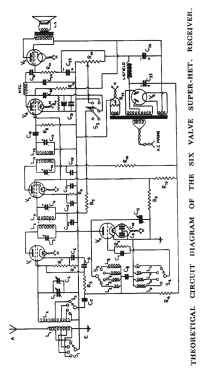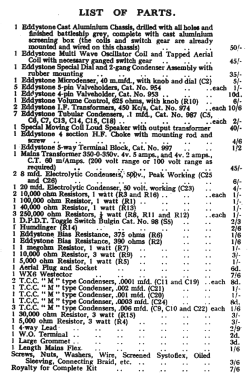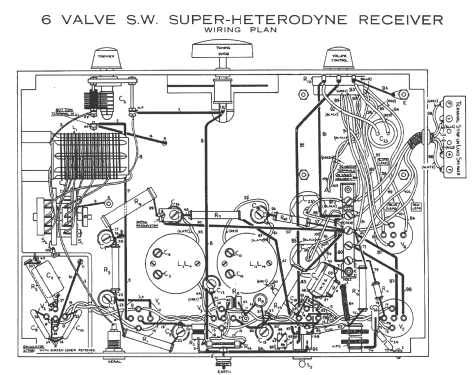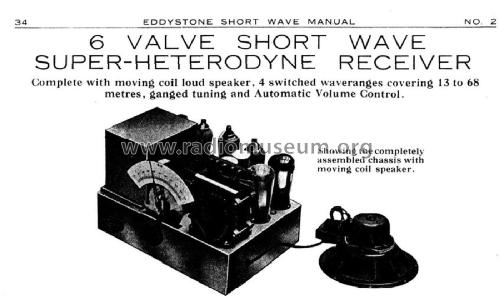Six-Valve Shortwave Superheterodyne
Eddystone (Brand), Stratton and Co., Ltd., Eddystone Radio Ltd.; Birmingham
- Country
- Great Britain (UK)
- Manufacturer / Brand
- Eddystone (Brand), Stratton and Co., Ltd., Eddystone Radio Ltd.; Birmingham
- Year
- 1935 ?
- Category
- Kit (Parts plus instruction) or building instructions only
- Radiomuseum.org ID
- 355308
Click on the schematic thumbnail to request the schematic as a free document.
- Number of Tubes
- 6
- Number of Transistors
- Semiconductors
- WX6
- Main principle
- Superheterodyne (common)
- Wave bands
- Short Wave (SW only)
- Power type and voltage
- Alternating Current supply (AC)
- Loudspeaker
- Electro Magnetic Dynamic LS (moving-coil with field excitation coil)
- Material
- Metal case, TUBES VISIBLE
- from Radiomuseum.org
- Model: Six-Valve Shortwave Superheterodyne - Eddystone Brand, Stratton and
- Shape
- Chassis only or for «building in»
- Notes
-
Six-Valve Shortwave Superheterodyne Kitset: Detailed Breakdown
This kitset offers a complete shortwave radio experience, featuring:
- Six Valves: This includes a full-wave rectifier for power conversion and a metal rectifier for automatic volume control (AVC).
- Superheterodyne Design: It employs the superheterodyne principle, converting received signals to a fixed intermediate frequency (IF) for easier amplification and filtering.
Signal Processing Stages:
- First Detector: A screened-grid valve functions as an anode-bend rectifier, converting the received radio signal to an IF signal.
- Local Oscillator: A separate triode valve generates the necessary oscillation signal for frequency mixing in the superheterodyne process.
- Intermediate Frequency (IF) Amplifier: A variable-mu-screened pentode amplifies the IF signal at a fixed frequency of 450 kHz.
- Second Detector: A screened high-frequency pentode with power grid rectification demodulates the IF signal to recover the audio information. This stage uses resistance coupling to connect to the output valve.
- Output Stage: A directly heated pentode valve provides power amplification for the audio signal.
Tuning and Controls:
- Ganged Tuning: A ganged capacitor simplifies tuning by adjusting both the antenna circuit and oscillator simultaneously across four-wave ranges. A small trimmer capacitor fine-tunes the antenna circuit for optimal reception.
- Four Wave Ranges: The switchable wave ranges cover a broad spectrum from 13 to 68 metres, approximately 21.4 to 4.4 MHz.
- Automatic Volume Control (AVC): An AVC circuit with a dedicated metal rectifier (WX6) automatically adjusts the gain to maintain consistent audio volume even with varying signal strengths. A switch allows you to bypass the AVC and use a manual volume control for more precise adjustments.
Construction Details:
- Robust Chassis: The receiver, including the power supply, is built on a sturdy cast aluminum alloy chassis, providing a reliable foundation for assembly.
- Effective Shielding: The coil unit utilizes a one-piece metal casting to shield the oscillator circuit, minimizing unwanted signal interactions (interlocking).
- High-Quality Transformer: The mains transformer is designed for exceptional performance, ensuring good voltage regulation without overheating.
Further Information:
This kitset was comprehensively described in Eddystone Shortwave Manual No. 2 (1935), on pages 34-38.
- Mentioned in
- - - Manufacturers Literature (Eddystone Shortwave Manual No. 2 1935, Pages 34 - 38)
- Author
- Model page created by Gary Cowans. See "Data change" for further contributors.
- Other Models
-
Here you find 255 models, 125 with images and 46 with schematics for wireless sets etc. In French: TSF for Télégraphie sans fil.
All listed radios etc. from Eddystone (Brand), Stratton and Co., Ltd., Eddystone Radio Ltd.; Birmingham



